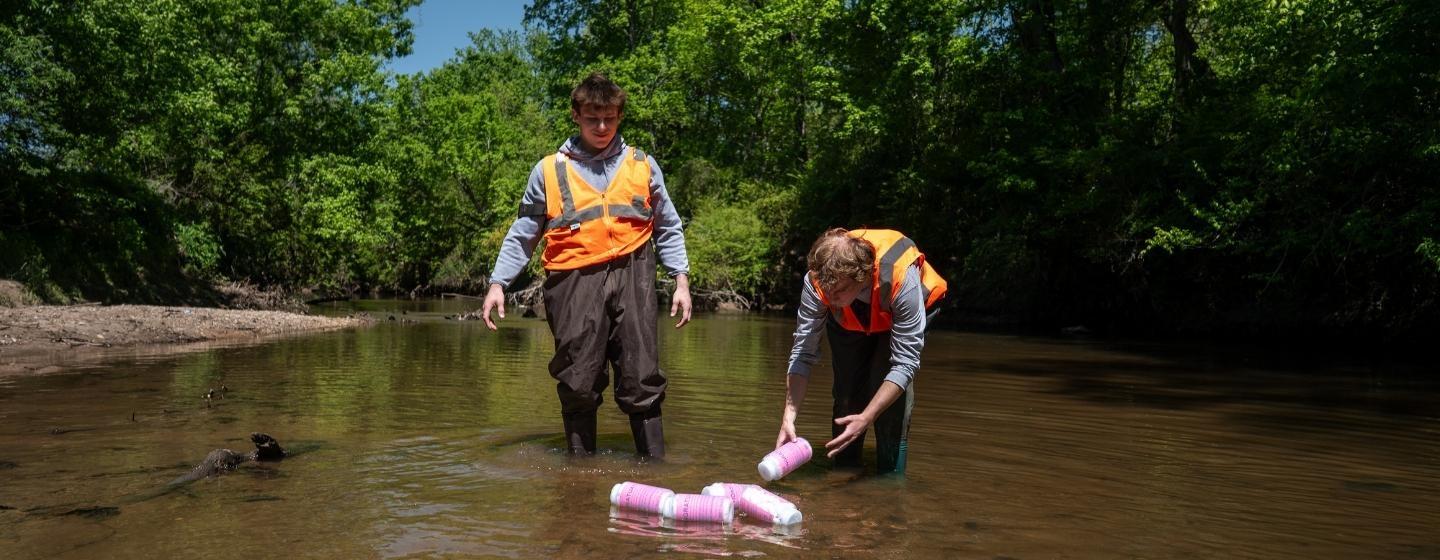Tracking Trash to Discover the Path of Plastic


You’re probably familiar with the saying “out of sight, out of mind.” The idea is that once something isn’t seen anymore, it’s no longer a problem. Throwing something in the trash or litter on the side of the road are good examples. But the problem is that even if you don’t see litter anymore, it doesn’t go away.
That’s why researchers from NC State have dumped 40 GPS-outfitted plastic bottles into creeks in Raleigh. They want to find out how daily trash in the capital city eventually ends up polluting North Carolina’s waterways and, ultimately, the Atlantic Ocean.
“Every time it rains, litter washes into waterways, and it’s easy to see how ugly it is when it all clumps together in the corners of creeks or behind fallen trees,” said Madison Haley, an NC State doctoral student helping to run the trash-tracking project. “But the trash keeps going downstream, and it breaks up into microplastics and leaches chemicals, and all of it is harmful to our health and to the health of the environment.”
Those tiny pieces of plastic are eaten by smaller animals and fish. The chemicals are absorbed by micro-organisms in the environment. It’s all concentrated into larger amounts as you go higher up the food chain.
“That means it eventually ends up in your fish dinner,” said Haley.
In 2014, scientists estimated there were 5.25 trillion pieces of plastic debris in the ocean. About 269 thousand tons float on the surface, and about four billion plastic microfibers per square kilometer drift in the deep sea. Most of that trash ends up in the ocean via rivers. It’s a major problem, but since so much of that trash is made up of things we use every day, we can all do something to solve it.
“We know that every time it rains, litter that is in parking lots and along roadsides washes into storm drains and then into creeks,” said Barbara Doll, Ph.D., an NC State professor of biological and agricultural engineering who specializes in water-quality issues. “We want to know how far down the creek and river the trash will travel. We know that rainfall makes a big difference not only in sending litter into the creek but also in how far it goes.”
Researchers first tested the bottle-tracking experiment by releasing 10 bottles into Marsh Creek and another 10 into nearby Crabtree Creek. They discovered that some bottles traveled almost 25 miles in only a few weeks.
The plastic bottle tracking is part of an extensive National Oceanic and Atmospheric Association–funded study about litter involving trash traps in creeks, microplastic testing and behavioral studies on why people litter. Researchers are combining science, technology and public engagement to learn more about how to develop practical solutions to stop litter before it enters rivers and makes it to the coast.
The goal for the project is to create cleaner neighborhoods and healthier waterways and put together a toolkit of proven litter reduction strategies that any city can adopt.
In addition to the GPS tracking device, each bottle also has a QR code on the label. Researchers are asking anyone who finds a bottle to scan it, upload a photo of where they found it and log the location. That helps to verify the GPS data. Folks who find the bottles are also asked to leave them where they found them. The teams will ultimately collect the bottles.
Anyone can follow the paths of the bottles on the project’s online “Trash Tracker.” Researchers plan to release more bottles in different weather conditions later this year to learn about how heavy rain affects stream flow and how far and fast the bottles travel.
Follow researchers as they show first-hand how microplastics get into our waterways and beaches.